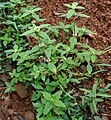
Psidium is a genus of trees and shrubs in the family Myrtaceae. It is native to warmer parts of the Western Hemisphere.

Anredera is a genus of plants native to Latin America, the West Indies, Texas, and Florida. Some are naturalized in other regions. Most of them evergreen vines of dry scrubland and thickets. Members of the genus are commonly known as Madeira vines. At least one species, A. cordifolia bears edible roots or tubers and leaves similar to those of Basella alba. The same species has become an invasive plant in many tropical and subtropical regions outside its natural range.

Rauvolfia is a genus of evergreen trees and shrubs, commonly known as devil peppers, in the family Apocynaceae. The genus is named to honor Leonhard Rauwolf. The genus can mainly be found in tropical regions of Africa, Asia, Latin America, and various oceanic islands.
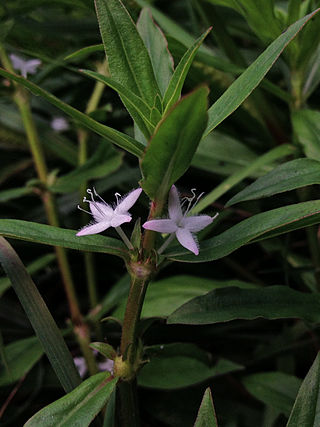
Diodia is a genus of flowering plants in the family Rubiaceae. It was described by Carl Linnaeus in 1753. The genus is found from southern and eastern United States, South America, Central America, Mexico, the West Indies and tropical Africa.
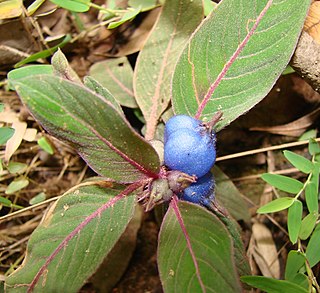
Coccocypselum is a genus of flowering plants in the family Rubiaceae. It is native to Mexico, Central America, the West Indies and South America. All species of the genus Coccocypselum are herbaceous with fleshy, blue or purple fruits, and 4-petaled flowers.
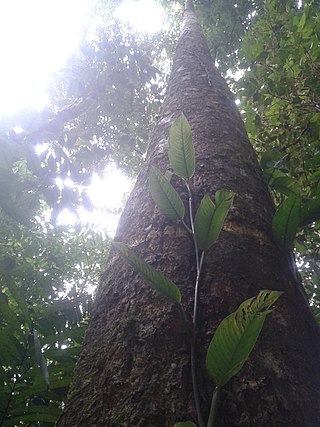
Pleodendron is a genus of plants in family Canellaceae described as a genus in 1899.

Hexasepalum teres is a species of flowering plant in the coffee family known by the common names poorjoe and rough buttonweed. This annual plant is native to Mexico, Central America, South America, the West Indies and the United States from California to Florida and from Kansas to Massachusetts. The species is also naturalized in the Netherlands, the Canary Islands, Western Africa, Angola, China, Japan and Korea, India, and Madagascar.

Lasiacis (smallcane) is a genus of Neotropical plants in the grass family, found in the Americas from Mexico and Florida south to Argentina.

Catesbaea is a genus of flowering plants in the family Rubiaceae. It occurs in the West Indies, The Bahamas, and the Florida Keys. The genus is named in honour of English naturalist Mark Catesby.

Crusea is a genus of angiosperms in the family Rubiaceae. The genus is found in the south-western United States, Mexico, and Central America. A few species are naturalized in Cuba and Puerto Rico.

Spermacoce remota, the woodland false buttonweed, is a species of plant in the Rubiaceae. It is native to the southeastern United States, West Indies, Mexico, Central America and South America. It is naturalized in Taiwan, Southeast Asia, China (Guangdong), India, Sri Lanka, New Guinea, Mauritius and many other oceanic islands.
Spermacoce neoterminalis, the Everglades Key false buttonweed, is a species of plant in the Rubiaceae. It is endemic to southern Florida, from the Everglades as far north as Lake Okeechobee.
Spermacoce ovalifolia, the broadleaf false buttonweed, is a species of plants in the Rubiaceae. It is native to Mexico, Central America, parts of the Caribbean, and South America.
Spermacoce brachysepala, the West Indian false buttonweed, is a plant species in the Rubiaceae. It is native to Puerto Rico, Haiti and the Dominican Republic.
Spermacoce keyensis, the Florida false buttonweed, is a species of plants in the family Rubiaceae, first discovered in the Florida Keys. It is found in southern Florida, Bahamas, and the extreme southern tip of Texas.

Spermacoce alata, the winged false buttonweed, is a species of plant in the Rubiaceae. It is widespread across the warmer parts of the Western Hemisphere and naturalized in many other parts of the world.
Spermacoce glabra, smooth false buttonweed, is a New World species of plants in the coffee family.
Spermacoce prostrata is a species of plants in the Rubiaceae. In the United States, it is widespread in Florida, with a few isolated populations in Alabama and Mississippi. The species is native to Mexico, Central America, the Caribbean (Bahamas, Cuba, Hispaniola, Puerto Rico, Trinidad, Turks & Caicos, the Lesser Antilles, and the Dutch and Venezuelan Antilles. It is also widespread in South America, found in every country except Chile. The species is reportedly naturalized in Hawaii, China, Japan, Taiwan, Sri Lanka, Thailand and Java.
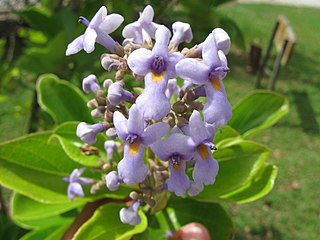
Cornutia is a genus of plants in the family Lamiaceae, first described in 1753. Species in this genus are native to tropical parts of the Western Hemisphere, including southern Mexico, Central America, the West Indies, and northern South America.
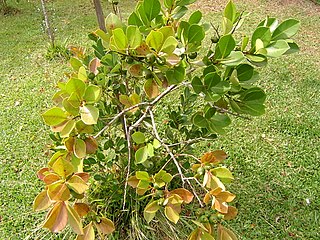
Mosiera is a genus of shrubs and small trees in the family Myrtaceae, first described as a genus in 1933. It is native to Mexico, Guatemala, the West Indies, Brazil, and Florida.

















